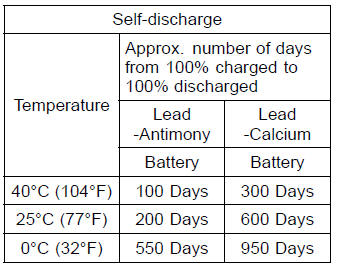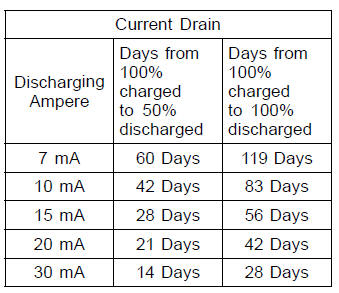

The battery installed in this motorcycle is a sealed type, so it is not necessary to check the battery electrolyte level or add distilled water.
The sealing strip should not be pulled off once the specified electrolyte has been installed in the battery for initial service.
However, in order to maximize battery life and ensure that it will provide the power needed to start the motorcycle you must properly maintain the battery’s charge. When used regularly, the charging system in the motorcycle helps keep the battery fully charged. If your motorcycle is only used occasionally or for short periods of time, the battery is more likely to discharge.
Due to their internal composition, batteries continually self discharge.
The discharge rate depends on the type of battery and ambient temperature.
As temperature rises, so does the discharge rate. Every 15°C (59°F) doubles the rate.
Electrical accessories, such as digital
clocks and computer memory, also
draw current from the battery even
when the key is switched off. Due to
a combination of such “key-off” draws
and hot temperature, a battery can go
from fully charged to completely discharged
in a matter of days.


In extremely cold weather the fluid in an inadequately charged battery can easily freeze, which can crack the case and buckle the plates. A fully charged battery can withstand sub-freezing temperature with no damage.
 Tire Wear, Damage
Tire Wear, Damage Battery Sulfation
Battery SulfationStarter Clutch Assembly
Install the one-way clutch [A] to the driven gear.
Face the circlip side of the one-way clutch to inside.
Install the new snap ring [B] to the one-way clutch.
Install the drive gear [C] while turn it counterclockwise [D].
Apply molybdenum disulfide oil solution to the needle
bearing ...
Drive Chain
The drive chain slack and lubrication
must be checked each day before riding
the motorcycle and must be maintained
in accordance with the Periodic
Maintenance Chart for safety and to
prevent excessive wear. If the chain
becomes badly worn or maladjusted -
either too loose or too tight - the c ...
Jump starting
If your motorcycle battery is “run
down”, it should be removed and
charged. If this is not practical, a 12
volt booster battery and jumper cables
may be used to start the engine.
DANGER
Battery acid generates hydrogen
gas which is flammable and
explosive under certain conditions.
It i ...